I’ve had these copies forever – a bunch of pages referring to an Averbeck/Overbeck lineage that as of yet has no verified connection to Hiddinghausen – but I never managed to translate the text… until now. Thanks to the miracles of modern smartphone technology, I was able to snap pics of the pages and have the photos app translate everything. So what follows is the scanned images of the pages along with the rough translation.
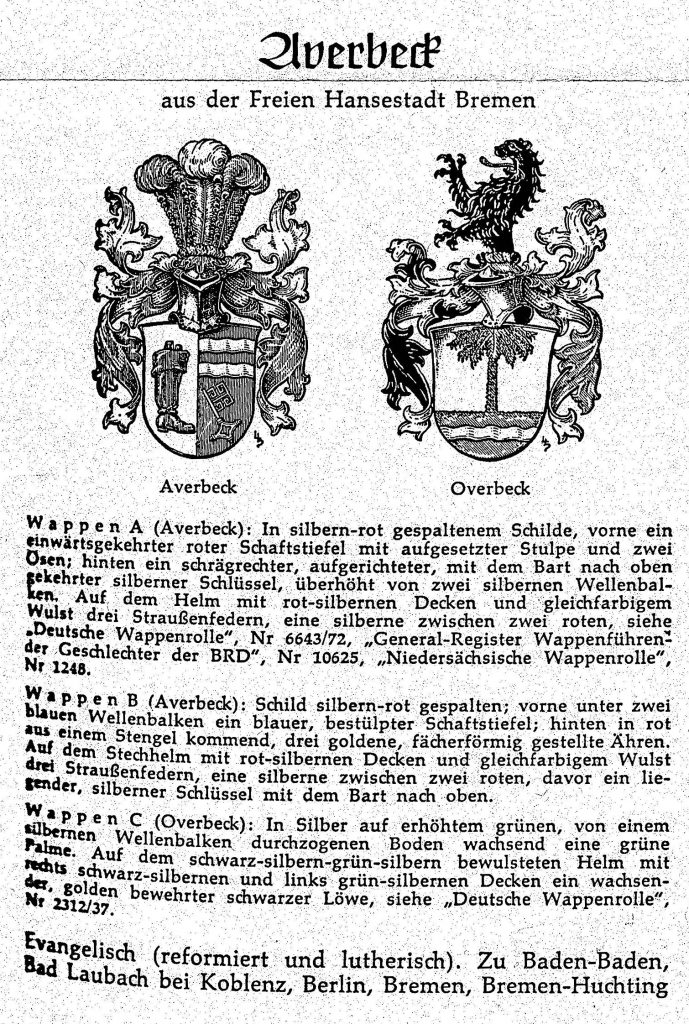
Averbeck – from the free Hanseatic city of Bremen
Coat of arms A (Averbeck): In silver-red split shield, in front an inward-turned red shaft boot with attached cuff and two roses; at the back an oblique, erected silver key swept upwards with the beard, elevated by two silver wave bars. On the helmet with red-silver blankets and same-colored bead three ostrich feathers, one silver between two red, see •German coat of arms roll”, No. 6643/72, “General Register Coat of Arms: Of the sexes of the FRG”‘, No. 10625, “Lower Saxony coat of arms roll”
Coat of arms B (Averbeck): Shield silver-red split; in front under two blue wave beams a blue, confirmed Shaft boots; red at the back Coming from a stem, three golden, fan-shaped ears of corn. On the piercing helmet with red-silver blankets and the same-colored bead, three ostrich feathers, a silver one between two red, in front of it a lying, silver key with the beard upwards.
Coat of arms C (Overbeck): Growing in silver on raised green soil crossed by a silver wave beam, a green palm tree. Grow on black-silver-green-silver beaded helmet with right black-silver and left green-silver blankets, the, the, golden reinforced” black lion, see “German coat of arms roll”
Evangelical (reformed and Lutheran). To Baden-Bader Bad Laubach near Koblenz, Berlin, Bremen, Bremen-Huchtin…

Kirchhuchting, Brockhuchting), Bremen-Oberneuland (Block-diek, Oberneuland, Rockwinkel), Bremen-Osterholz (Ellen, Osterholz), Detmold, Dresden, Göschwitz an der Saale, Hamburg, Hanover, Jena, Kaltenbrunn in the Upper Palatinate, Kiel, Koblenz, Cologne, Lemgo, Schwalenberg in Lippe, Serbitz/Sudetenland, Teplitz-Schönau/Sud., Weimar.
The name Averbeck (Averbäck, Averbecke, Auerbecke, Aberbeck, Overbeke, Overbecke, Oferbeck, etc.) is a Lower German secondary form to Overbeck, in the meaning “Above the creek / beyond the creek = over the beke” Today it is widely used mainly in the southern Oldenburg and West German language area (cf. Max Gottschald, German naming; Rudolf Zoder, surname in Ostfalen).
The origin of the sequence described here could not be determined correctly. It can be assumed as certain that the parent home of the family is northern Germany, and it is reasonable to assume that it can be found near Bremen or in Bremen itself, since the earliest natural deposits were found in Bremen. The copies of the Bremen citizen’s books – almost all originals fell into the hands of the Russian occupation troops at the place of storage at the end of the war in 1945 and have since been untraceable – are the oldest namesakes to show the following
A(O)verbeck from:
1387 – Albert Overbeke, as a witness (son of a citizen),
1387 – Albert Overbeke, Bürgereid (possibly Son of the previous),
1418 – – Hille Overbeke, Albert’s wife, citizen oath,
1487 – – Hans Overderbeke, Bürgereid,
1508 – Johann Overbeke, Bürgereid (possibly Son of the previous),
1525 – Johann Averbecke, as a witness
1545 – Johann Overbeke, as a witness (possibly Son of the previous one),
1566 – Arnt Averbeke, as a witness (regular father of the ge-gender, vmtl. Son of the previous one),
1581 – Arnt Averbek, as a witness
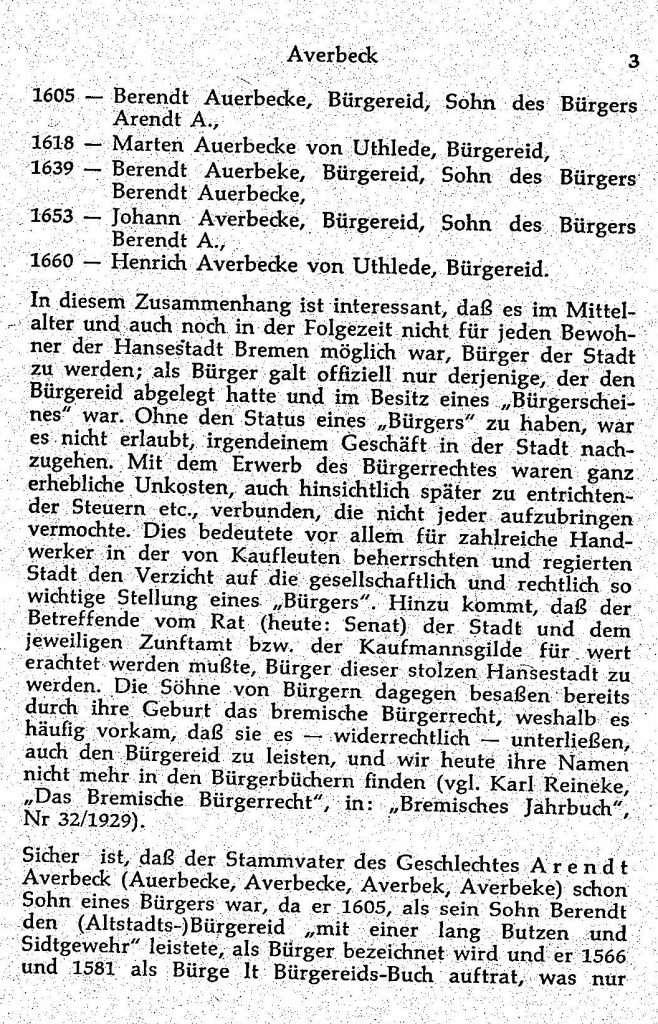
1605 – Berendt Auerbecke, Bürgereid, son of the citizen Arendt A.
1618 – Marten Auerbecke of Uthlede, Bürgereid,
1639 – Berendt Auerbeke, Bürgereid, son of the citizen
Berendt Auerbecke,
1653 – • Johann Averbecke, Bürgereid, son of the citizen Berendt A.
1660 – Henrich Averbecke of Uthlede, Bürgereid.
In this context, it is interesting that in the Middle Ages and even in the following period it was not possible for every inhabitant of the Hanseatic city of Bremen to become a citizen; only the one who had taken the oath of citizens and in possession of a citizen’s license was. Without having the status of a “citizen”, it was not allowed to do any business in the city. The acquisition of civil rights involved very considerable expenses, including with regard to taxes payable later, etc., which not everyone was able to pay. This meant the renunciation of the socially and legally important position of a “citizen” especially for numerous craftsmen in the city dominated and governed by merchants. In addition, the person concerned had to be considered worthy by the council (today: Senate) of the city and the respective guild office or the merchant guild to become a citizen of this proud Hanseatic city. The sons of citizens, on the other hand, already had Bremen citizenship at birth, which is why it often happened that they refrained – unlawfully – from taking the oath of citizens, and today we can no longer find their names in the citizens’ books (cf. Karl Reineke, Bremen Civil Rights, in: Bremish Yearbook, No. 32/1929).
What is certain is that the ancestor of the Arendt Averbeck family (Auerbecke, Averbecke, Averbek, Averbeke) was already the son of a citizen, since in 1605, when his son Berendt took the (old town) civil oath “with a long slug and sidd rifle”, he was referred to as a citizen and he appeared in 1566 and 1581 as a citizens’ book, what only…
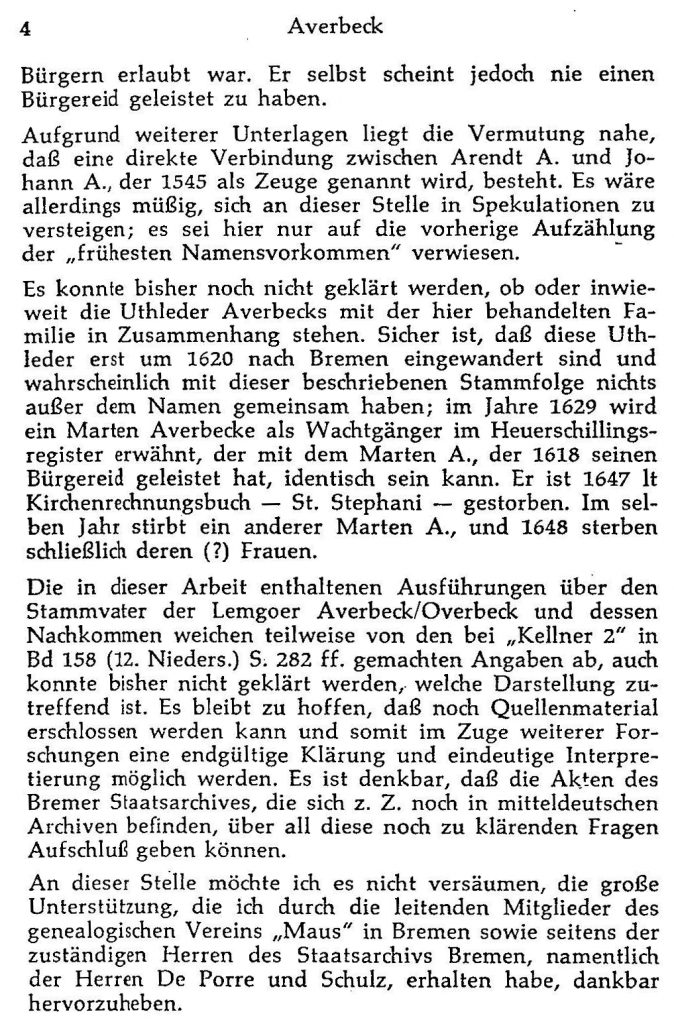
citizens were allowed. However, he himself never seems to have taken the oath of citizens.
On the basis of other documents, it is reasonable to assume that there is a direct connection between Arendt A. and Johann A., who is named as a witness in 1545. However, it would be idle to get into speculation at this point; reference should only be made to the previous list of the “earliest name occurrences”.
It has not yet been possible to clarify whether or to what extent the Uthleders of Averbeck are related to the family treated here. What is certain is that these Uth leathers did not immigrate to Bremen until around 1620 and probably have nothing in common with this described sequence except the name; in 1629, a Marten Averbecke is mentioned as a watchdog in the Heuerschillings register, which may be not really just journey OK so we ran into the products identical to Marten A., who took his oath of citizens in He is 1647 It Church accounting book – St. Stephani – died. In the same year, another Marten A. dies, and in 1648 their (?) finally die. Women.The remarks contained in this work about the ancestor of Lemgoer Averbeck/Overbeck and his descendants partly deviate from those of “Kellner 2” in Vol 158 (12. Lower.) P. 282 et seq., it has also not yet been possible to clarify which presentation is correct. It is to be hoped that source material can still be tapped up and thus a final clarification and clear interpretation will be possible in the course of further research. It is conceivable that the files of the Bremen State Archives, which are e.g. Currently still in Central German archives, about all these questions still to be clarified can provide information.
At this point, I would like to thankfully highlight the great support received from the senior members of the genealogical association “Maus” in Bremen as well as from the responsible gentlemen of the State Archives Bremen, namely Messrs. De Porre and Schulz, received, to be gratefully acknowledged.

In this sequence, only parts of the 2. Lem-goer tribe, the 1st Bremen tribe with omission of the Bremen main branch – the latter has not yet been genetically recorded – otherwise the entire sequence would have become too extensive, which would have made publication in this gang impossible.
Thus, the aim of this work, which cannot claim to be complete, is to lay the foundation for further family history research and to form an incentive for other families called Averbeck/Overbeck to become aware of their ancestors and to remember them in an appropriate way with this first Averbeck tribal sequence in the DGB.
With the gradual decline of craftsmanship in the Free Hanseatic City of Bremen at the beginning of the 17th century. Century, it can certainly also be explained why the founder of the Lemgo main tribe, the shoemaker, later pensioner and councilor of Lemgo, Arendt Averbecke/ Overbecke (II b), whose descendants today bear the name Overbeck, emigrated from Bremen around 1605 (source 4). Similar things also apply a few decades later to the descendants of the Bremen main tribe, whose founder is Berendt Averbecke, the brother of the previous one (source 6). His grandson Arendt (IV b), who had immediately become his ancestor Schuster, remains loyal to his hometown, but soon hangs up the awl and boots and follows a vocation as a sexton and schoolmaster in 1674 to Oberneuland (today:Bremen-Oberneuland), where he held his positions for 43 years. A street in Bremen-Oberneuland will soon be named after him.
After the death of his son in 1739, three builders (large farmers) The Historian Prof. Dr. Maßolle and the lawyer Dr. Kurt Entholt, both from Bremen, often refer to these builders in their works on the history of the Oberneuland parish, who brought it to high state and ecclesiastical offices and dignity in those days. They owned one of the two saddle-free estates (i.e. they…

in contrast to the other Meier farmers, they did not have to provide clamping services), which existed in Holler and Blockland (one of the four Gohe in the Bremen land area).
This estate “Averbeck” with its approximately 320 acres Country (cf. B. Lindemann, “Easter wood once and now”, Bremen 1968) was one of the largest in the entire Bremen region. From that time also comes the Foundation, which is only affected by inflation after the 1st World War II was dissolved. The Averbecksche Hof became the property of the Kaemena family in 1842 by marrying the widow Averbeck, who still manages it today, after the last heir Averbeck, Wöltje (= VII, 1), died in 1839 without serfs. His three brothers had already been resigned by a treaty in 1804 (cf. StAB/Sign. 2-Q. 3. B. 13. f. 2).
The stately courtyard, which burned down for the first time in 1788 and for the second time in 1967, was rebuilt and stands in the former Rockwinkel-Blockdiek, today’s Bremen-Oberneuland, at Rockwinkler Landstraße 153.
The centuries-long connection of the family, in particular the Averbeck line, with the Hanseatic city of Bremen was only interrupted in 1880, when Dr. Heinrich Averbeck (1844-1889) (X) gave up his practice, Am Brill 12, for professional reasons, and moved to Baden-Baden, Ludwig-Wilhelms-Platz 2, to manage the H. Averbeck” (see “Guide through Baden-Baden” Marx was ibid. 1880; Address book Baden-Baden and Baths-Almanac, born in 1882), which he founded until 1881 together with Dr. Senff led to take over.
For this, around the same time with Wilhelm Overbeck (1835-1915) (Annex A, V), the director of A. G. Weser shipyard in Bremen a descendant of the approx. 250 years earlier, Arend A(O)verbecke (1580 to 1647) back to the family’s home. Thus, this old tradition of the integration of the family with the Free Hanseatic City of Bremen has been unconsciously maintained by the Overbeck line to this day.
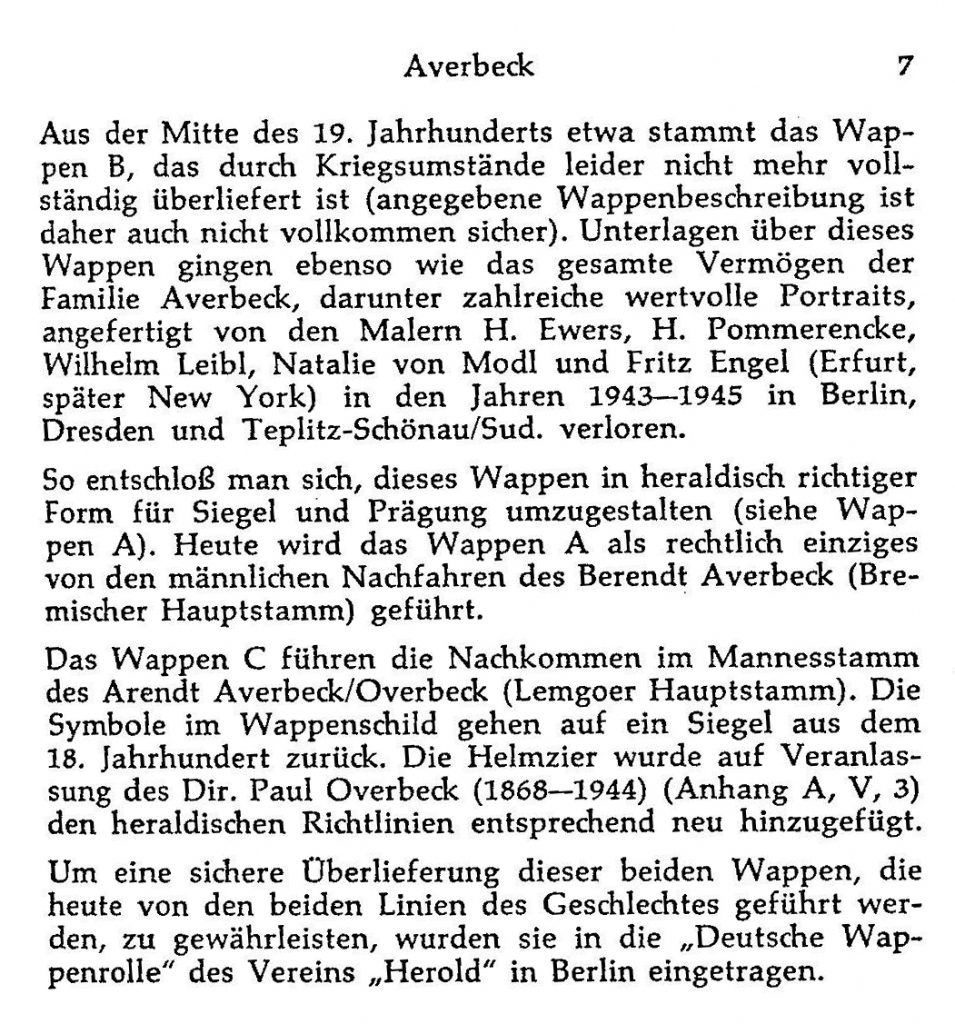
From the middle of the 19th century Century, for example, comes the coat of arms B, which unfortunately is no longer completely handed down due to war circumstances (the given coat of arms description is therefore not completely certain). Documents about this coat of arms went as well as the entire assets of the Averbeck family, including numerous valuable portraits, made by the painters H. Ewers, H. Pommerencke, Wilhelm Leibl, Natalie von ModI and Fritz Engel (Erfurt, later New York) lost in the years 1943-1945 in Berlin, Dresden and Teplitz-Schönau/Sud.
Thus, it was decided to redesign this coat of arms in heraldic correct form for seal and embossing (see coat of arms A). Today, the coat of arms A is the only one legally maintained by the male descendants of Berendt Averbeck (Bremischer main tribe).
The coat of arms C is carried by the descendants in the male tribe of Arendt Averbeck/Overbeck (Lemgo main tribe). The symbols in the coat of arms go on a seal from the 18th Century back. The helmet ornament was created at the instigation of Dir. Paul Overbeck (1868-1944) (Annexs A, V, 3) in accordance with the heraldic guidelines.
In order to ensure a reliable tradition of these two coats of arms, which are now led by the two lines of the family, they were registered in the “German Wappenrolle” of the association “Herold” in Berlin.
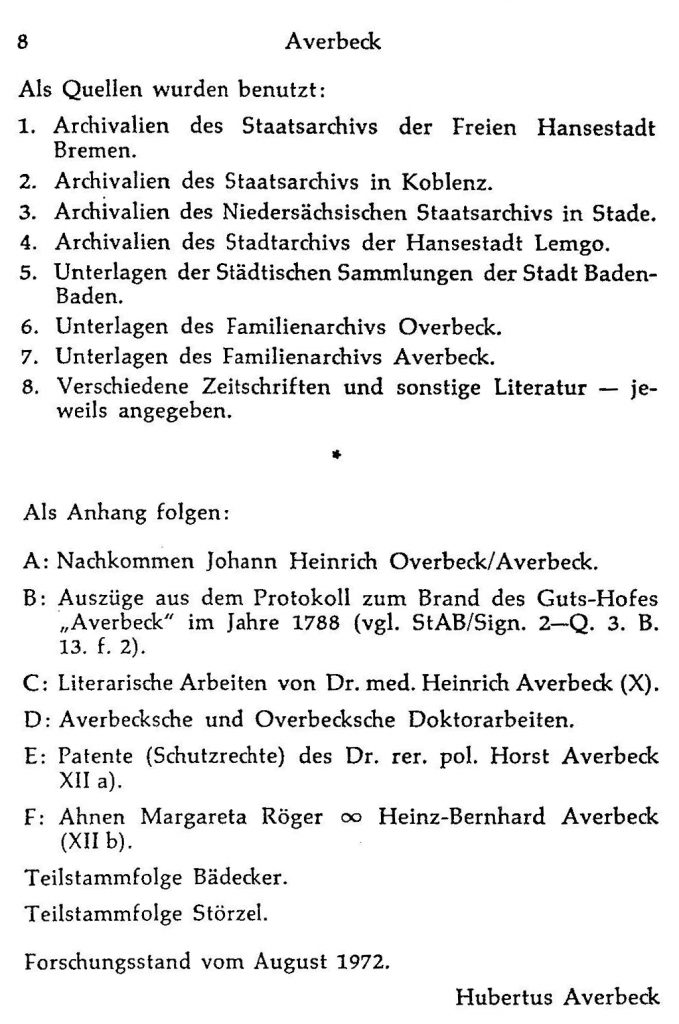
The following were used as sources:
1. Archival materials of the State Archives of the Free Hanseatic City of Bremen.
2. Archival materials of the State Archives in Koblenz.
3. Archival materials of the Lower Saxony State Archives in Stade.
4. Archival materials of the city archive of the Hanseatic City of Lemgo.
5. Documents of the municipal collections of the city of Baden-Baden.
6. Documents of the Family Archive Overbeck.
7. Documents of the Averbeck Family Archive.
8. Different journals and other literature – each indicated.
Please find attached:
(various articles that weren’t scanned)
State of research from August 1972 – Hubertus Averbeck